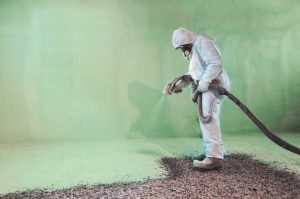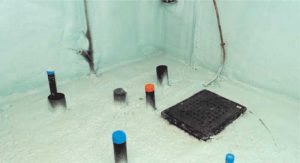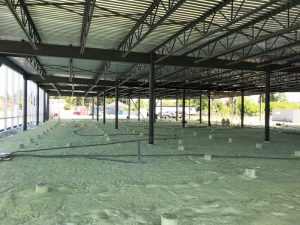
Preventing radon infiltration using closed cell spray polyurethane foam
Radon is a gas released when the elements uranium, thorium, and radium—all present in rocks and soil—undergo a natural decaying process. The resulting radon is an invisible, odorless, and tasteless gas which seeps up through the ground and into the air. It is radioactive and typically exists outdoors, albeit in low quantities. Since radon is naturally present outside, we all breathe it in daily in low levels. However, when the gas is inhaled in higher levels, the substance puts an individual at increased risk of developing lung cancer. In fact, research from the American Lung Association asserts radon is the second leading cause of lung cancer in the U.S., responsible for thousands of deaths each year.
Exposure causes no immediate symptoms; however, the long-term threat of the disease is significant to many. Approximately 21,000 people die of radon-related lung cancer each year, and 2900 of those deaths represent individuals who have never smoked.
Radon testing methods
Due to the direct proximity of the basements and ground levels of commercial structures to soil and rock matter, as well as to the gaseous movement of radon upward through that matter and into the air, there is risk to the users of commercial facilities should the gas infiltrate and accrue in more dangerous amounts indoors. Therefore, it is important to test for radon to ensure the safety of commercial building users, whether managers, workers, customers, or visitors.

Guidance and best practices information on the array of methods for detection and means for reducing radon infiltration in buildings is provided by the U.S. Environmental Protection Agency (EPA). Since 2012, the EPA has been actively participating in the radon industry-led ANSI/AARST voluntary consensus-based standards (VCS) process. The AARST Consortium on National Radon Standards is a non-profit organization owned by the American Association of Radon Scientists and Technologists (AARST). The consortium is an American National Standards Institute (ANSI)-approved standards developer. Both the EPA and the AARST consortium, on their respective websites, provide radon mitigation guidance for structures including large commercial facilities, schools, apartment buildings, and homes.
Additionally, Kansas State University, through its National Radon Program Services (NRPS), provides information on the two common categories of radon test devices utilized to measure levels of the gas within structures. The first category of test devices is passive, or powerless, and these short-term tests include alpha track detectors, charcoal canisters, and charcoal liquid scintillation detectors. Some charcoal technologies are prone to interference by high humidity, so they may not be appropriate for use in all buildings. However, they may be available in hardware and drug stores, as well as on the internet and in some laboratories. Another type of passive device, an electret ion chamber (EIC) detector, is usually only accessible via laboratories. After use, passive tests return to a lab for analysis.
The second category of radon detection devices is active. These require power and encompass continuous monitors and continuous working level monitors. Some active monitors can provide data on the range of variation within the test period. Others can detect and deter interference. However, they usually require operation by trained testers and are often more expensive than passive device options. Technical information on the various devices for measuring radon may be found in the EPA publication, Indoor Radon and Radon Decay Product Measurement Device Controls. The National Radon Proficiency Program (NRPP) provides a Find a Radon Mitigation or Measurement Professional database tool as well.
How and where radon enters the structure

As the National Cancer Institute (NCI) points out, radon can accumulate in areas with direct proximity to soil and in places without adequate ventilation, including in underground and ground-floor spaces. In these locations, radon may accumulate in higher levels, substantially increasing the risk of lung cancer. Because of their direct proximity to the ground soil, it is possible specifically for basements as well as the ground level of commercial and institutional facilities to become such dangerous spaces.
Radon can infiltrate the structure in several key places. Because radon is gaseous, the common pathways for its entry into the building will include any locations in the low levels of the structure which are adjacent to soil matter and can allow the gas to flow through. Common entry points include cracks and openings in the floor slab, cracks in the foundation wall, and sump pits. Despite the risk of radon accumulation in commercial and institutional buildings, there are solutions which effectively seal entry points and stop the radioactive gas from penetrating commercial structures and accumulating inside in dangerous levels.
One radon solution: Closed cell spray polyurethane foam
Closed cell spray polyurethane foam (SPF), a thermal, air, and vapor barrier solution, is commonly used to insulate and seal the building envelope of commercial facilities of all types including schools and hospitals, as well as office, retail, industrial, and agricultural buildings. The insulation is well-known as a solution for enhancing energy efficiency in structures. The professionally applied material offers a high compressive strength and, because of its physical properties upon application, adheres with ease and self-seals around penetrations such as cracks.
While closed cell spray polyurethane foam is perhaps best known for its insulation capabilities and air and vapor barrier performance, it may also be applied in key places to minimize, or stop, the infiltration of radon into basements and the ground levels of commercial and institutional facilities. Some closed cell SPFs have been tested for their ability to prevent radon from entering structures. Manufacturers of these closed cell spray foam options should provide information on the third-party testing their product has undergone to meet the radon-resistant requirements. For closed cell spray foam, a K124/02/095 (method C of ISO/TS 11665-13) test may be completed to prove the product’s resistance to radon infiltration.

The following six-step process outlines how to utilize radon-resistant closed cell spray foam as a solution to prevent entry of the gas into commercial buildings. It is important to note open cell spray polyurethane foam, a class of spray foams offering a density around 8 kg/m3 (0.5 lb/cf), does not work in this spray foam application in lieu of medium-density closed cell spray foam, which offers a density around 32 kg/m3 (2 lb/cf). Open cell spray foam is porous, whereas closed cell spray foam is rigid and its closed cell, non-porous structure does not allow gas to flow through it.
Six-step spray foam solution
Install depressurization pipe
The first step in leveraging the power of closed cell spray foam for radon abatement is to install a depressurization pipe. A pipe, perforated and 101.6 mm (4 in.) in diameter, must be installed in a 19.05-mm (0.75-in.) gravel net and run to the center of the surface of the floor slab. This preventatively installed pipe is connected to an exhaust fan if, after the work is completed, a test indicates a radon concentration of more than 200 Bq/m3 (5.4 pCi/L).
Install water drains
Step two of the radon abatement process will be to install water drains. It is important to note radon can use water as a vehicle for infiltrating the structure. Therefore, it is necessary to install floor drains specifically designed to prevent entry of the gas.
Apply air barrier
The third step in the process is to install an air barrier. A closed cell spray foam system may be utilized since it performs as an effective air barrier. The spray foam selected should be ICC compliant and tested in accordance with ASTM E2178. Closed cell spray foam provides complete airtightness under the foundation slab as well as thermal insulation. However, the spray foam selected also needs to be proven radon gas resistant, as demonstrated by the K124/02/95 (method C of ISO/TS 11665-13) test, while offering more than 65 times greater effectiveness than a 0.15-mm (6-mil) polyethylene membrane at 31.75 mm (1.25 in.). The spray foam should be applied in a minimum thickness of 31.75 mm (1.25 in.) to meet insulation, air tightness, and vapor retarder requirements.
Seal joints
Step four is a sealing of joints. The seamless continuity of closed cell spray polyurethane foam provides a seal to the foundation wall joint to the foundation, leaving no seams in the basement or ground-level insulation anywhere, including wall, slab, and rim joist. Spray foam adheres and molds perfectly to the building structure and no sealant, tape, or cutting of materials is required. This equates to zero compatibility issues between materials.
Seal all openings
Sealing all openings is step five of the process. The closed cell spray foam seals openings and posts, leaving no room for error. The material seals and expands to 30 times its initial volume in just five seconds when applied. It penetrates through the gravel, creating a full surface adhesion. The system is also more resistant to puncture than other commonly applied products, including polyethylene sheet and membranes, allowing for workers to walk on top of it without damaging the integrity of the gas barrier.
Install sealed lid on sumps
The sixth and final step in the process will be to install a sealed lid on sumps. Because sumps can communicate directly with gravel and, therefore, act as an origin of radon, it is imperative for builders to utilize specifically designed lids.
There are additional benefits to applying closed cell spray foam as under slab insulation, as is outlined in this six-step process for radon abatement. The application is very quick and can equate to savings achieved for labor. Product cost will ultimately be lower per volume as well, since the applicator’s travel time and prep are offset by the volume to install. This is especially true when compared with conventional insulation systems such as rigid board with poly, tape, and sealants, which involve more steps, several materials, and additional labor—all of which open the door for more risk of error.
Closed cell spray polyurethane foam, because of its sealing capabilities, also prevents other unwanted elements from entering the building. These include insects, as well as unfiltered air from the outdoors which may include harmful pollutants and allergens. As a secondary water barrier, the durable material helps to protect the facility against the formation of mold and mildew which, when combined with the ability to keep polluted air out, improves indoor comfort for building users. Finally, when applied as an insulation, closed cell spray foam provides improved energy efficiency, reducing the energy consumption of the building and ultimately reducing long-term energy bills.



 Maxime Duzyk is director of building science and engineering for Huntsman Building Solutions. He has a background in architecture and has been in the spray polyurethane foam insulation business for the last 10 years. Duzyk is involved with different building envelope committees and associations in North America, including CSC, SFC, SPFA, CCMC, and ULC Standards.Visit Huntsman Building Solutions online at www.huntsmanbuildingsolutions.com and contact Maxime at mduzyk@huntsmanbuilds.com
Maxime Duzyk is director of building science and engineering for Huntsman Building Solutions. He has a background in architecture and has been in the spray polyurethane foam insulation business for the last 10 years. Duzyk is involved with different building envelope committees and associations in North America, including CSC, SFC, SPFA, CCMC, and ULC Standards.Visit Huntsman Building Solutions online at www.huntsmanbuildingsolutions.com and contact Maxime at mduzyk@huntsmanbuilds.com
